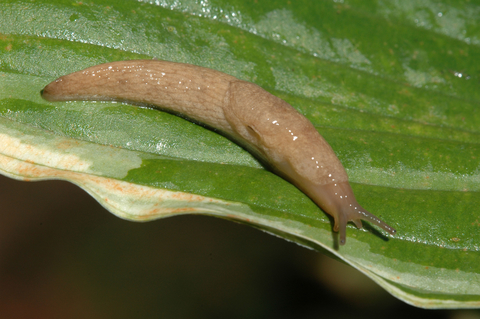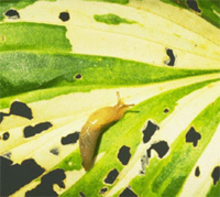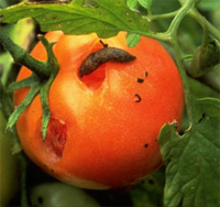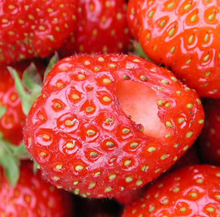Quick facts
- Slugs are present from spring to fall, in cool, moist areas with shade.
- Slugs feed on leaves of many plants (especially seedlings), ripening fruits and vegetables, and decaying plant matter.
- Extensive feeding can result in a weak or dying plant.
- There are several nonchemical steps to combat slugs.
- Insecticidal baits are also available if necessary.
How to identify slugs
Slugs can be described as snails without shells. They are a type of mollusk, related to clams and oysters.
- Slugs are slimy and soft bodied, without any legs.
- They are generally brownish or grayish.
- Their head contains two pairs of feelers. A larger pair above carries the eyes and a lower pair below is used for smelling.
- They can range in size from 1/4 inch to two inches or longer.
Slugs produce slime and use it to move. A dried slime trail indicates slugs are active in your garden.
Biology of slugs
Slugs are generally active at night when it is cool and damp, although they may be seen during the day in cool, shaded sites. Warm, dry conditions are less favorable to them.
- Slugs typically spend the winter as eggs in protected sites, like under plant debris, mulch, boards or in the soil.
- Eggs hatch the following spring and early summer.
- If conditions are favorable, slugs can be active throughout the summer and fall.
- Slugs have a layer of slime to protect their skin from drying up.
Slugs feed on a variety of ornamental plants that grow in part to full shade as well as fruits and vegetables. Some plants they are likely to damage include bellflower (Campanula), larkspur (Delphinium), plantain lily (Hosta), daylily (Hemerocallis), Dahlia, lungwort (Pulmonaria), strawberries, basil, beans, cabbage and lettuce.
Ground covers like spotted dead nettle (Lamium maculatum) create an inviting slug habitat by shading soil and keeping it cool and moist.
Generally, slugs do not bother plants that grow in full sun.
Damage caused by slugs
- Slugs use file-like mouthparts (called a radula) to rasp and chew plant tissue.
- Because of their mouthparts, they create irregularly shaped holes in leaves, flowers and fruit.
- Low to moderate feeding can affect the appearance of plants but usually does not impact plant health.
- Severe slug feeding can injure plants, especially seedlings.
- It can also reduce the harvest of fruits and vegetables, especially when plants are young. Older plants are more tolerant of defoliation.
How to protect your garden from slugs
If slugs are a problem in your home garden, it is best to use a variety of steps to reduce their numbers. Wet conditions caused by excessive shade or poorly drained soil can increase slug numbers.
- Look for slugs under plants where it is shady, cool and protected.
- The risk of slug feeding is higher during times of cloudy and rainy weather.
- Slime trails are signs of slug activity.
- In the evening, use a flashlight to locate slugs.
Discourage slugs by creating lighter, drier conditions.
- Prune lower tree branches and shrubs to allow more sunlight to reach plants and soil.
- Divide or thin plants to improve air circulation, allowing the soil surface to dry out.
- Stake plants and prune lower leaves to raise plants off the soil and away from slugs.
- If planting in rows, make plant rows narrow (12 to 18 inches wide).
- If soil is constantly damp, improve drainage by amending soil with compost.
- While chopped leaves make an excellent mulch, too much can encourage slug habitat. Remove and compost extra leaves in spring.
- Remove or relocate materials where slugs hide such as containers, boards, pavers and flat stones.
Grow a water-wise garden
- Slugs are active in the evening; water plants in the morning so water is absorbed and plants dry.
- Water the root zone at the base of the plant.
- Avoid overhead watering.
- Water by hand or use drip irrigation or soaker hoses.
- Do not water leaves, flowers, fruit or vegetables.
- Plants for drier conditions and full sun (6+ hours of sun):
- Perennials: yarrow (Achillea), wormwood (Artemisia), milkweed (Asclepias species), asters, coneflowers (Echinacea, Rudbeckia), hardy mums (Dendranthema species), ornamental grasses, iris, Shasta daisy (Leucanthum superbum), gayfeather (Liatris), lily (Lilium), bee balm (Monarda), phlox (Phlox maculata, I), balloon flower (Platycodon), sage (Salvia), stonecrop (Sedum), painted daisy (Tanacetum), false lupine (Thermopsis), tulips, daffodils, crocus and other early spring bulbs
- Ornamental grasses: blue oats grama (Bouteloua), reedgrass (Calamagrotis), bloodgrass (Imperata), moor grass (Molinia), switchgrass (Panicum), fountaingrass (Pennisetum), prairie dropseed (Sporobolus heterolepis)
Grow shade plants that slugs do not like
- For full shade (6+ hours of shade):
- Perennials: Creeping phlox (Phlox stolonifera), woodland phlox (Phlox divaricata), bleeding heart (Dicentra)
- Ferns
- Ornamental grasses: tufted hairgrass (Deschampsia), hakone grass (Hakonechloa)
- Sedges: Gray’s sedge (Carex grayi), Pennsylvania sedge (C. pensylvanica), Japanese sedge (C. morrowii), plantain sedge (C. plantaginea)
- For light to part shade (3-4 hrs, dappled sunlight):
- Perennials: Monkshood (Aconitum), lady’s mantle (Alchemilla), columbine (Aquilegia), swamp milkweed (Asclepias incarnate), false spirea (Astilbe), turtlehead (Chelone), bugbane / snakeroot (Actaea), pinks (Dianthus), spurge (Euphorbia), cranesbill (Geranium), coral bells (Heuchera), catmint (Nepeta), evening primrose / sundrops (Oenothera), spiderwort (Tradescantia)
- Ornamental grasses: oatgrass (Helictotrichon), reedgrass (Calamagrostis), blue fescue (Festuca glauca)
- Sedges: blue sedge (Carex flacca), palm sedge (Carex muskingumensis)
- Clematis: Grow this flowering vine on a trellis or fence in full sun, but with the base of the plant shaded and cool.
- Slugs do not typically damage trees and shrubs.
Handpick slugs off plants
- Look for slugs on leaf surfaces and underneath leaves as well as under rocks and debris.
- Drown slugs in soapy water or crush them.
Set out several flat boards, shingles or damp newspapers
- Check under these traps the next morning and kill any slugs that are hiding.
- Repeat this step night after night until the slug damage is no longer present.
Set out beer traps
- Bury containers into the ground so the top of the container is level with the ground.
- Pour beer or a water and yeast mixture (one teaspoon of yeast to three ounces of warm water) or similar fermenting liquid into the container, 6-7 inches deep. The liquid should be about one inch below the top of the pan.
- Attracted to the odor, slugs fall into the liquid and drown when they try to drink.
- Check traps at least several times a week and clean them out and refill as needed.
- Be sure to put out enough traps to protect the entire garden, especially when slugs are numerous.
Copper
Copper has been shown to deter slugs by reacting with their mucous, which gives slugs something like an electrical shock. Copper foil or bands may be used horizontally or vertically, but they must be wide enough to accommodate the whole slug.
Not all copper strips or tape sold for slug control is wide enough to be effective. These types of copper barriers are most practical for small gardens and containers.
Caution: The sharp edges of some products may cause safety problems, especially for young children.
Diatomaceous earth
Diatomaceous earth (tiny fossilized skeletons of ancient aquatic diatoms) is coarse and can scratch up slugs. It is most effective when used in dry conditions and has little effect when it absorbs moisture. It is generally not an effective slug deterrent.
There are many types of animals that feed on slugs: beetles (ground beetles, rove beetles, fireflies), toads, snakes, turtles, shrews, ducks, starlings and other birds.
Encourage these natural enemies when practical in your garden.
Be aware that using pesticides to kill slugs may also harm these natural enemies. If you use chemicals for other issues, spot-treat small pest problems or use baits.
If nonchemical steps don't reduce slug damage, there are baits available to treat them with a pesticide.
- Apply the bait in the late afternoon or evening close to the time when the slugs become active.
- Sprinkle bait around the plants that are being protected.
Iron phosphate
Iron phosphate is a stomach poison that damages the slug’s digestive system.
- It is a less toxic bait for slugs; it does not pose problems when used around children and pets.
- Slugs stop feeding several days after eating iron phosphate and eventually die (up to seven days).
- Iron phosphate is effective for two weeks, even if it becomes wet.
Ferric sodium EDTA
- A less toxic product similar to iron phosphate.
- It works more quickly, killing slugs in just a few days
Metaldehyde
Metaldehyde is attractive and very toxic to dogs and other animals, so avoid using this product if pets can enter a garden where this bait may be applied.
- When slugs eat metaldehyde, it quickly dehydrates and kills them.
- Metaldehyde is more effective during warm, dry weather.
CAUTION: Mention of a pesticide or use of a pesticide label is for educational purposes only. Always follow the pesticide label directions attached to the pesticide container you are using. Be sure that the plant you wish to treat is listed on the label of the pesticide you intend to use. And observe the number of days between pesticide application and when you can harvest your crop. Remember, the label is the law.
Reviewed in 2020





